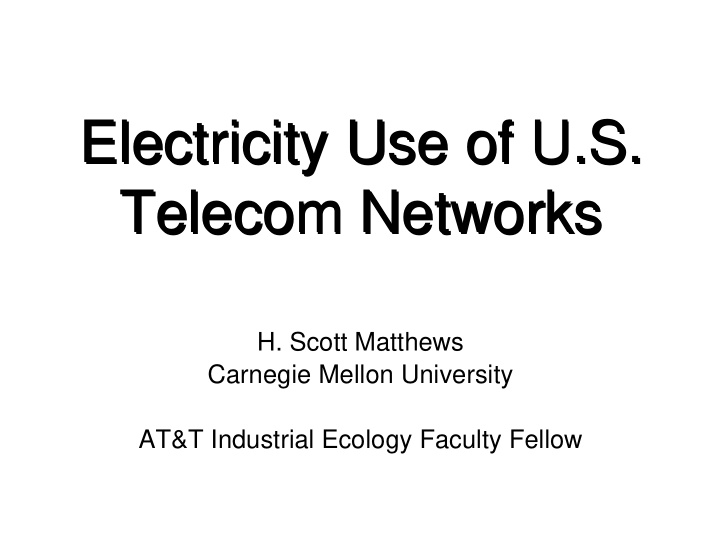



Electricity Use of U.S. Electricity Use of U.S. Telecom Networks Telecom Networks H. Scott Matthews Carnegie Mellon University AT&T Industrial Ecology Faculty Fellow
Agenda • Re-motivation - Why we need to care about electricity use (esp. for electronics) • Previous research • Scope of Study • Results and Commentary
Energy Flow Diagram QuickTime™ and a TIFF (Uncompressed) decompressor are needed to see this picture.
System Losses 36.3 GJ 32.7 GJ Electricity Grid Customer 10% Distribution/ Transmission Power We lose, on average, 80% of the Supply 40% energy we extract when using it for electronic products 19.6 GJ
Our Prior Research • Previously measured wired, wireless, and total electricity use of CMU campus network • Total: ‘network’ uses 5% of campus electricity (~5 MkWh / yr) • Wireless ‘equipment’: 5-10x less electricity than wired • While not purely generalizable, an indicator of the potential energy efficiency of wireless
Relevant Prior Research • Blazek et al, compared Stockholm (Sweden) and Sacramento (CA, USA) phone networks • Roth et al, “Electricity Consumption of Office and Residential Equipment”, for US Department of Energy, 2002. • Our campus wired-wireless study • Common thread: ICT devices and systems may be significant consumers of electricity
Definitions • PSTN = Publicly Switched Telephone Network • a.k.a. the wired network, originally built by AT&T (power supplied by line, except for cordless phones) • Mobile network = system of stations, antennas, handsets, etc. needed to support wireless telecommunications • Includes ‘cell towers’, sites, etc.
Stockholm/Sacramento Report • These 2 cities were comparable in terms of size, population, users, etc. (although Stockholm much more ‘mobile’) • Report estimated network size, equipment requirements, etc. for both cities’ networks • Also estimated materials, environmental, and energy requirements (including support/service activities like administrative offices) • We used these estimates as a basis
US Wired Network Stockholm Sacrament Model o Model Total (TWh/yr) 28 24 Per connection 0.14 0.12 (MWh/yr)
US Wireless Network Stockholm Sacrament Model o Model Total (TWh/yr) 5 5 Per connection 0.04 0.04 (MWh/yr)
But.. • Wireless / mobile network is not entirely wireless! • Except for small fraction of wireless calls, most calls go through wired network • Need to allocate some fraction of wired network electricity to wireless calls • We use call-minutes as a proxy - 2500 billion wired, 500 B wireless (15%) in 2000
Adjusted US Wireless Network Stockholm Sacrament Model o Model Total (TWh/yr) 8 7 Per connection 0.06 0.06 (MWh/yr) Watts/call 16 15 minute Even when adjusted, wireless 2x more energy efficient
Overall Results Stockholm Sacrament Model o Model Total Wired + Mobile 33 29 (TWh/yr) Percent Mobile 25% 25% Percent US 1% 1% Elec
Facts • In 2002, International Telecommunications Union (ITU) noted the number of wired and wireless ‘lines’ roughly equal (about 1 billion each) • Global wireless subscribers growing rapidly • Wired subscribers flat (and declining in US)
Wired vs. Wireless electricity (Watts per subscriber) Thus, electricity use ‘per subscriber’ will rapidly favor wireless and trend to 10x
Final Thoughts • ‘Efficiency’ of wireless (versus wired) communications is irrelevant! • For foreseeable future, we will have need for wired networks (if nothing else, to make long-range mobile calls!) • This dependency will limit our ability to realize energy savings from wireless • i.e., until we ‘pull the plug’, we are using more total energy to have both to use
Recommend
More recommend